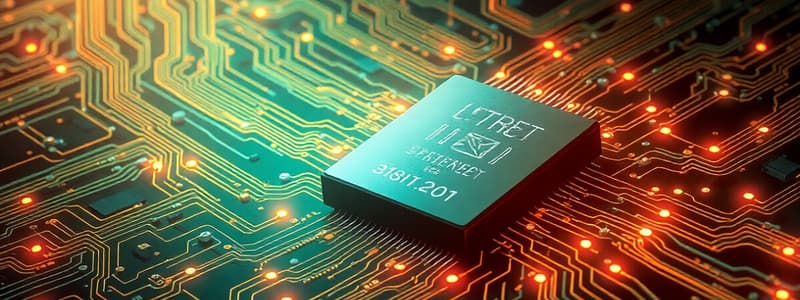Podcast
Questions and Answers
What is a primary characteristic that distinguishes active components from passive components?
What is a primary characteristic that distinguishes active components from passive components?
- Passive components can control current flow.
- Passive components can generate electric energy.
- Active components can only accept energy.
- Active components require an external source for operation. (correct)
Which of the following is an example of an active component?
Which of the following is an example of an active component?
- Capacitor
- Transistor (correct)
- Inductor
- Resistor
How do active components contribute to a circuit compared to passive components?
How do active components contribute to a circuit compared to passive components?
- Active components can only act as loads.
- Active components do not require energy to operate.
- Active components help maintain a constant voltage.
- Active components provide power gain. (correct)
What is true about the VA characteristic curve of an active component?
What is true about the VA characteristic curve of an active component?
What defines passive components in a circuit?
What defines passive components in a circuit?
Flashcards
Active Components
Active Components
Components that generate or control electric energy. They require external power and act as energy donors in a circuit.
Passive Components
Passive Components
Components that consume or utilize power in a circuit. They don't require external power and act as loads.
Examples of Active Components
Examples of Active Components
Transistors, diodes, integrated circuits, solar cells, and silicon controlled rectifiers (SCRs) are examples of active components. They control and amplify electrical signals.
Examples of Passive Components
Examples of Passive Components
Signup and view all the flashcards
VA Characteristic Curve Slope
VA Characteristic Curve Slope
Signup and view all the flashcards
Study Notes
Active Components
- Active components are capable of generating or controlling electric energy.
- They differ from passive components by their ability to provide power gain.
- They require an external source for operation.
- Active components act as energy donors and sources of power in a circuit.
- The slope of a voltage and current (VA) characteristic curve of an active element is negative.
- They can control current flow, acting as the source of current flow in a circuit.
- Examples of active components include:
- Transistors
- Diodes
- Integrated circuits
- Solar cells
- Silicon controlled rectifiers
Passive Components
- Passive components utilize power or energy in a circuit.
- They require no external source for operation.
- They are energy acceptors and act as a load in a circuit.
- The slope of a VA characteristic curve of a passive element is positive.
- Passive components cannot control current flow in a circuit.
- Some examples of passive components include:
- Resistors
- Capacitors
- Inductors
- Transformers
- Photodetectors
- Seven-segment displays
- Variable resistors
- Semiconductor devices
- Gas-filled devices
Studying That Suits You
Use AI to generate personalized quizzes and flashcards to suit your learning preferences.
Description
Test your knowledge on the differences between active and passive electronic components. This quiz covers the definitions, examples, and characteristics of both types of components, providing insight into their roles in electrical circuits.




